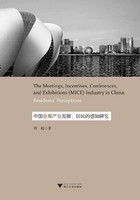
 1.5 Hangzhou's Tourism Development
1.5 Hangzhou's Tourism Development
Crouch (2000) noted that places are but one pervasive component of leisure and tourism, nonetheless they are an important component. Hangzhou is a tourism-based city through its inheritance of lake, mountains and other scenic resources. Hangzhou has two designated state-level scenic spots—the West Lake Scenic Area, and the Two Rivers and Two Lakes (Fuchun River, Xin'an River, Qiandao Lake and Xianghu Lake) Scenic Area; two state-level nature reserves—Mount Tianmu, Qingliang Peak Nature Reserve; seven state-level forest parks—Qiandao Lake, Mount Wuchao, Fuchun River, Mount Daqi, Mount Banshan, Yaolin Forest and Qingshan Lake parks; a state-level tourist resort—Zhijiang National Tourist Resort Area and the country's first state-level wetland park—Xixi National Wetland Park. Hangzhou also has 25 national conservation sites of cultural heritage and 9 national museums. As a result, Hangzhou has been regarded as ‘China's best tourist city' by the China National Tourism Administration (CNTA) and the United Nations World Tourism Organisation (UNWTO), and won the award of the ‘Oriental Leisure City' by the World Leisure Organisation. The West Lake was also inscribed on the World Heritage List by UNESCO in 2011. Hangzhou's economy is increasing dramatically, and one positive effect is that having residents with more real income has also aided the tourism economy to develop.
As one of the key national scenic tourism cities, Hangzhou takes tourism as a key to its prosperity. In recent years, with an increasing emphasis on the tourism industry at all levels, Hangzhou has improved its tourism infrastructure, undertaken new promotions and initiatives, and with its historical and cultural attractions, Hangzhou has started to catch the world's attention. In order to stimulate its tourism industry, many coordinated statutes have been promulgated by the local government. The most representative policy is the ‘free West Lake', which is also perhaps one of the more contentious policies executed by the Hangzhou government. According to Shao (2004), since 2002 when Hangzhou began the comprehensive West Lake protection project called ‘return the lake to the people', under which various attractions around the lake have been opened for free. The policy has attracted some criticism. By 2004, the entire West Lake had been opened for free. Because of inflation and increasing costs, this policy has been challenged and on many occasions has been in conflict with local public opinion, but the policy has brought a positive image to the city and gained good economic returns. According to the statistics from Hangzhou.com.cn (2010), for the national day holiday in 2010, hotel prices of the Yangtze River Delta increased, and Hangzhou increased the most. Also, budget hotel prices increased by 30%. It is obvious that the policy forgoes revenue from the sale of entry tickets to the lake, but it has attracted more tourists to come and extend their stay, which brings an impetus for the development of the restaurants, hotels, retail business, and other related industries.
There are many new and future tourism developments. Just two will be briefly covered as indicative of the developments in Hangzhou. Xixi is China's only nationally accredited wetland and covers an area of over 11 square kilometres. Being one of the three ‘Xi's along with the West Lake(Xihu)and Xiling Seal Engravers'Society,the wetland offers not only scenic beauty but also cultural resources with the Persimmon and Plum Festivals, dragon boat racing events and others taking place. Some of the new initiatives are also based on historical precedents—the earliest dragon boat races date back to 1465 there and the Persimmon and Plum Festivals back to the period of the 1600s. The ponds of the wetland have a long history as a source of aquaculture and festivals within the history of Hangzhou, and are being used for purposes of modern recreation, leisure, and tourism as well as environmental restoration and conservation.
The Beijing-Hangzhou Grand Canal district is like many such walks in other parts of the world which is being developed as a hub of restaurants and cafes that creates an outdoor meeting and dining area. The canal itself links Hangzhou with Beijing and dates from the 7th century.
There are a large number of tourists coming to Hangzhou every year. According to statistics, from 2010 to 2015, the city enjoyed obvious tourists growth (see Table 1.3).
Although foreign tourists have started to visit Hangzhou in an increasing number, the main tourism business in Hangzhou is still from its domestic visitors and the majority of tourists in recent years are domestic tourists.
